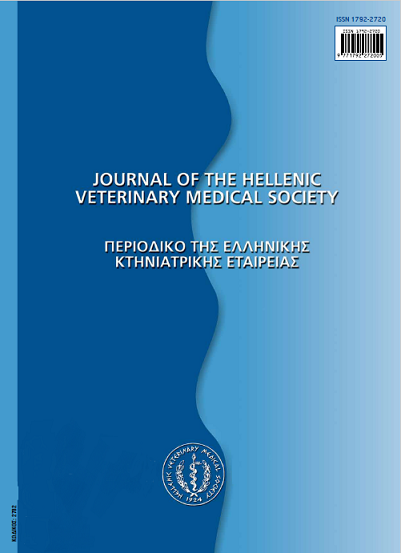Οι τιμές αναφοράς 23 κλινικά χρησίμων βιοχημικών παραμέτρων στον ορό του αίματος 107 κλινικά υγιών αλόγων αναψυχής στη Β. Ελλάδα

Περίληψη
Σκοπός της μελέτης ήταν ο προσδιορισμός τουεύρους των φυσιολογικών τιμών ("τιμές αναφοράς") των πλέονχρήσιμων από κλινική άποψη βιοχημικών παραμέτρων σε άλογααναψυχής που διατηρούνται σε βορειοελλαδικούς ιππικούς ομίλους.Το κλινικό βιοχημικό προφίλ περιλάμβανε 23 συνολικά παραμέτρους,όπως είναι οι ολικές πρωτεΐνες, οι λευκωματίνες, οισφαιρίνες και ο λόγος λευκωματινών προς σφαιρίνες, το άζωτο ουρίας,η κρεατινίνη, η γλυκόζη, η χολοστερόλη, τα τριγλυκερίδια, η ολικήκαι η άμεση χολερυθρίνη, η αλκαλική φωσφατάση (ALP), ηαλανινοαμινοτρανσφεράση (ALT), η ασπαραγινική αμινοτρανσφεράση (AST), η γ-γλουταμυλοτρανσφεράση (γ-GT), η κινάση τηςκρεατίνης (CK), η αφυδρογονάση του γαλακτικού οξέος (LD), ηαφυδρογονάση της σορβιτόλης (SD), ο φωσφόρος (Ρ), το ασβέστιο(Ca), το κάλιο (Κ), το νάτριο (Na) και το μαγνήσιο (Mg). Ταδείγματα αίματος πάρθηκαν από 107 κλινικά υγιή άλογα με βάσητο ιστορικό, την κλινική και την αιματολογική εξέταση. Οι μετρήσειςέγιναν στον ορό του αίματος με τις μεθόδους και τα αντιδραστήριαπου χρησιμοποιούνται στο Εργαστήριο της Κλινικής Διαγνωστικήςκαι Προπαιδευτικής Παθολογίας του Τμήματος Κτηνιατρικήςτου Α.Π.θ.. Εκτός από τον καθορισμό των τιμών αναφοράςκαθεμίας από τις παραμέτρους, στη συζήτηση σχολιάζονταιοι παράγοντες εκείνοι που επηρεάζουν προς τα πάνω ή προς τα κάτωτην τιμή της στο αίμα.
Λεπτομέρειες άρθρου
- Πώς να δημιουργήσετε Αναφορές
-
DIAKAKIS (Ν.ΔΙΑΚΑΚΗΣ) N., MYLONAKIS (Μ. Ε. ΜΥΛΩΝΑΚΗΣ) M. E., ROUBIES (Ν. ΡΟΥΜΠΙΕΣ) N., KOUTINAS (Χ.Κ. ΚΟΥΤΙΝΑΣ) C., FYTIANOU (Α. ΦΥΤΙΑΝΟΥ) A., & KOUTINAS (Α.Φ. ΚΟΥΤΙΝΑΣ) A. F. (2018). Οι τιμές αναφοράς 23 κλινικά χρησίμων βιοχημικών παραμέτρων στον ορό του αίματος 107 κλινικά υγιών αλόγων αναψυχής στη Β. Ελλάδα. Περιοδικό της Ελληνικής Κτηνιατρικής Εταιρείας, 53(2), 138–146. https://doi.org/10.12681/jhvms.15370
- Τεύχος
- Τόμ. 53 Αρ. 2 (2002)
- Ενότητα
- Research Articles

Αυτή η εργασία είναι αδειοδοτημένη υπό το CC Αναφορά Δημιουργού – Μη Εμπορική Χρήση 4.0.
Οι συγγραφείς των άρθρων που δημοσιεύονται στο περιοδικό διατηρούν τα δικαιώματα πνευματικής ιδιοκτησίας επί των άρθρων τους, δίνοντας στο περιοδικό το δικαίωμα της πρώτης δημοσίευσης.
Άρθρα που δημοσιεύονται στο περιοδικό διατίθενται με άδεια Creative Commons 4.0 Non Commercial και σύμφωνα με την άδεια μπορούν να χρησιμοποιούνται ελεύθερα, με αναφορά στο/στη συγγραφέα και στην πρώτη δημοσίευση για μη κερδοσκοπικούς σκοπούς.
Οι συγγραφείς μπορούν να καταθέσουν το άρθρο σε ιδρυματικό ή άλλο αποθετήριο ή/και να το δημοσιεύσουν σε άλλη έκδοση, με υποχρεωτική την αναφορά πρώτης δημοσίευσης στο J Hellenic Vet Med Soc
Οι συγγραφείς ενθαρρύνονται να καταθέσουν σε αποθετήριο ή να δημοσιεύσουν την εργασία τους στο διαδίκτυο πριν ή κατά τη διαδικασία υποβολής και αξιολόγησής της.










